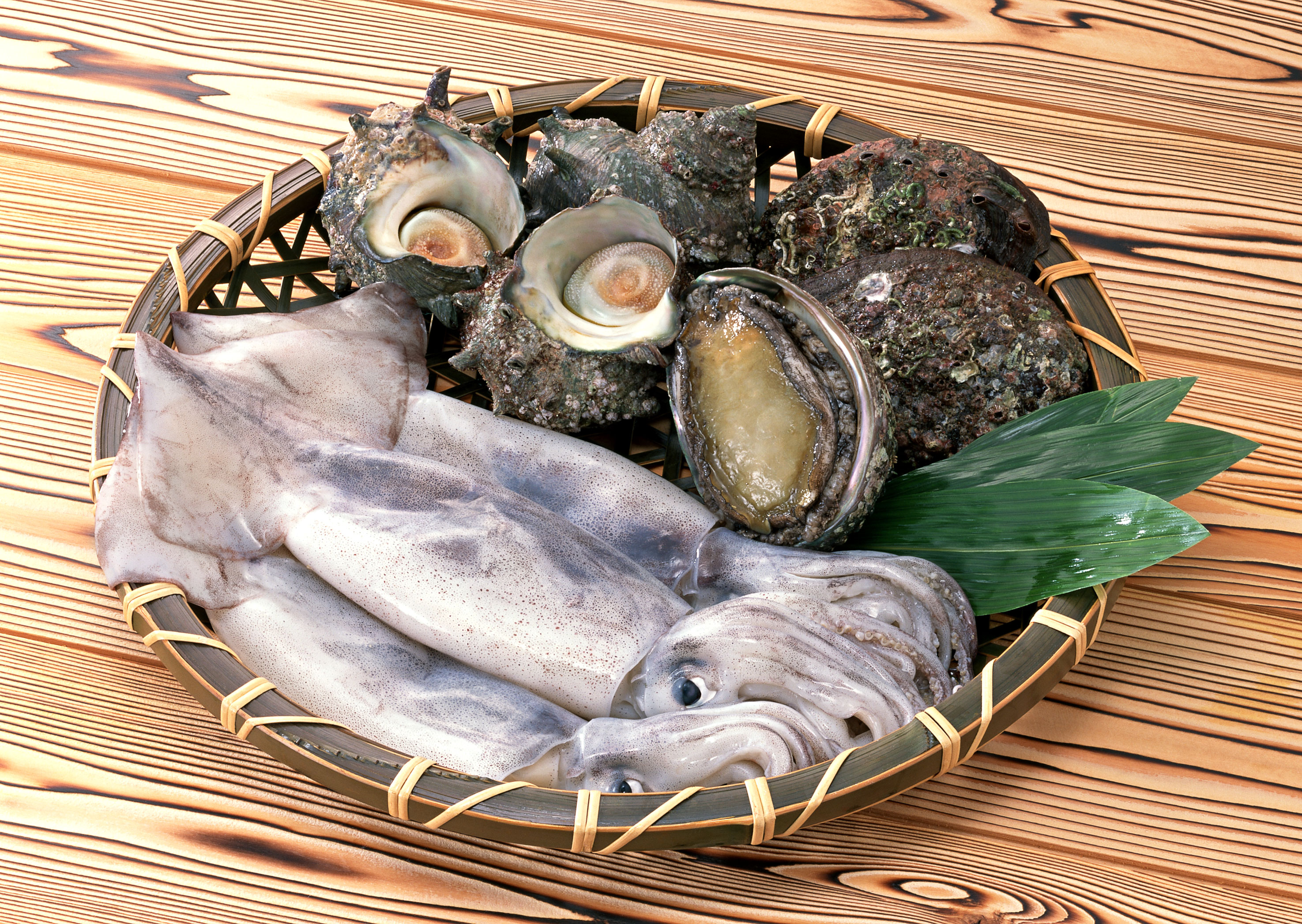Feature
As fresh as it gets
Fresh, raw ingredients are a key part of washoku. All very well when it’s simply veg, but how about the fleshy, beady-eyed, wriggly kind of raw? Foreign stomachs might need some extra training to prepare for this extreme washoku experience.
Washoku, Japan’s contribution to world cuisine, has been all over the news since its UNESCO Cultural Heritage inscription and its praises have been spread as thick as miso paste. Delicious it may be, some Japanese food is anything but easy for foreigners to swallow. Lacking dishes that are particularly spicy, sweet or sour, some washoku dishes make their mark with rawness. “But I like sushi!” you protest. Indeed, I did too. I ate plenty of cucumber rolls and the occasional sliver of salmon back home. Upon arriving in Japan I found that I had to pass several stages of rawness that I had never considered even edible, descending like Dante through rings of hell and just hoping that I’d pop out into culinary heaven in the end. Stage One: rolled sushi. Rawness is concealed. Stage Two: nigiri-zushi. A big piece of raw fish sits on a lump of rice. Stage Three: sashimi. A big piece of raw sea-creature without the pretense of rice. Most foreign visitors are aware of these levels, even if they aren’t able to conquer them. When dining back home, something one rarely sees is a head. Not so in washoku. I was served shrimp with their heads still attached and fish grilled whole on a skewer. Their glassy eyes bored into my soul and it took a lot of effort to clear Stage Four: food with faces. Close behind this tête-à-tête was Stage Five: eating those faces. Crunching up brains, eyes and various organs got easier when I started head-first and then moved on to the meatier tail. But eating whole creatures in single bites? There was something monstrous about swallowing hundreds of chirimen-jako (baby sardines) in one mouthful, like I was a creature of the depths in some Lovecraftian horror. But at least those little fish are dried.
Fast-forward several years. I walked into a Kanazawa restaurant with my hotel’s assurance that it served local specialties. The menu’s calligraphy was exquisite but completely impenetrable. Unable to order anything sensibly I uttered those four syllables of doom: o ma ka se. “It’s up to you.”
The chef nodded, smiling. I ordered some sake, feeling confident. I’d been in Japan a while and had cleared some stages of extreme washoku. My confidence began to flag at the first dish of fried whole shrimp. Stage Six was still frontier territory and not so easy. Shrimp are normal enough, I told myself and ate them without complaint. As if to taunt me, the following sashimi dish had a whole prawn, the bright blue color of its organs exposed. Gulping sake, it began to occur to me that the specialties of a seaside town probably wouldn’t include really great biscuits or a new take on the peanut butter sandwich. Then the real trouble arrived. “Hotaru-ika,” said my chef, serving up a plate of small, purple, formerly fluorescent firefly squid. Whole raw creatures were a heretofore avoided Stage Seven. I dunked the limp squidlettes in soy sauce and crunched up the hard beak inside their heads, wiping the sweat from my brow when that was done.
It was at that moment that the old man down the counter was served a large metallic bowl. He picked up a sieve and began scooping little wriggling fish into a dish of dipping sauce. I stared as one of them flipped off the sieve and made a break for it.
What was that!?! I asked myself in horror. I managed to choke down those little squid, but eating minnows? I’m glad I didn’t order that.
You can imagine my despair when I spotted a smiling waitress carrying a metallic bowl my way. She placed before me Stage Eight: live creatures. Within were four-centimetre-long clear fish. “Iwana- no-ko,” said my waitress. Baby char. They swam about the bowl vigorously, looking for a way out. I looked for a way out too, but my pride had me trapped. You can’t say omakase and then turn your nose up at what comes to your table, even if you think the staff is placing bets on your reactions.
I caught the fish with some difficulty and dumped them into the small bowl of ponzu sauce. Unsurprisingly, they didn’t appreciate moving from fresh water to citrus juice and thrashed wildly. Desperate to get them to stop moving, I doused them in soy sauce and waited while they suffocated in the salty brine. Steeling myself, I picked them up and chewed as fast as I could then chased each one with sake.
I was panting when the chef came out with one last plate. “A gift for our special guest, funazushi.” He placed a plate of fermented fish before me and I thanked him, even though intentionally rotten fish ranked high on my list of inedible foods. I was drunk and nothing could top those little fish, not even a rotten one.
Perrin Lindelauf (@perrinl) is the author of National Geographic Traveler: Japan, 4th Edition.
極めつけの生食
火を通さない新鮮な食材は、和食の基本である。その生食 される素材が、植物ならば まず問題はない。だがあまり に生々しく、皿の上から睨み 返し、まだ生き生きと動いて いるような動物はどうだろう。究極の和食体験を志す外国 人は、あらかじめ心の準備が 必要である。
和食がユネスコ無形文化遺産に登録されたことをきっかけに、日本の食文化への賞賛は世界中で広まっている。だが味の良さ はさておき、和食には口に入れるのさえ憚られる料理もある。 味覚の問題ではない。この国には、ナマナマしすぎる料理が存 在するのだ。
「でも寿司はみんな好きだよ」と、あなたは反論するだろう。私 自身もそうだった。母国ではかっぱ巻きがお気に入りだったし、 サーモンの刺し身も食べた。それでも日本にやってきて、乗り越 えなければならない幾つものステージがあることを知った。これ まで食べ物だとさえ思わなかったものを、覚悟を決めて食べる のだ。地獄へ降りるダンテのように、最後には食の天国へと到 達できることをただ祈りながら。
ステージ1は、巻き寿司だ。生の食材はまだ隠されている。ステ ージ2は、握り寿司。ごはんの上に、生魚が一切れ乗っている。 ステージ3は刺し身。海の生物をそのまま切り身にして、米の台 座なしで食べる。クリアできるかどうかは別にして、ここまでの ステージは大抵の外国人旅行者もご存じのはずだ。 西洋風の食事で、動物の頭部を目にすることは稀である。でも 和食は違う。エビは頭付きで出てくるし、全身を串刺しにされた 魚も見た。生気を失った彼らの目は、心に深く突き刺さる。とい うことでステージ4は、動物の顔付き料理。ここをクリアす るのに、私はかなり難儀した。
食材とのにらめっこが終わると、すぐ次の段階があ る。ステージ5では、その動物の顔を食べる。脳み そや目玉などを噛み砕くには、まず頭からかぶり つき、身の詰まった尾の方に向かうと食べやす い。しかし一口でたくさんの動物を食べる感覚 は別次元だ。何百匹ものちりめんじゃこを口に 入れたとき、自分がSFホラー映画の奇怪な生 物になったみたいでゾッとした。この小魚たち が乾燥してあったのは、せめてもの救いである。
それから数年後。金沢で宿泊先のホテルに訊ね、地元の名物が 食べられるという店に入った。筆書きのメニューは見事だが、読 解は不可能。自分で選ぶことは諦め、私は運命の言葉を口にし た。「おまかせで」。
笑顔でうなずく店主。自信を取り戻した私は日本酒を注文した。 思えば日本に来てしばらく経つし、困難なステージを幾つか乗り 越えてきた。だがそんな自信も、最初に出てきたエビの丸揚げ を見て揺らぎはじめる。ステージ6、動物の丸焼き。ハードルは 高いが、「エビなんてまだノーマルな方じゃないか」と自分に言 い聞かせ、文句を言わずに食べた。するとまるで私をからかうよ うに、次の皿ではクルマエビの活造りが青い内蔵をさらけ出し ている。酒をごくりと飲み干しながら、私はようやく気付き始め た。海沿いの街の名物なのだから、洒落たビスケットやサンドイ ッチというわけにはいかないのだぞと。
そして大きな難関がやってきた。「ホタルイカです」と店長。小さ な、紫色の、キラキラとしたイカたちが皿に盛られている。でき れば避けたかったステージ7、それは動物を丸ごと生で食べる 料理だ。ぐったりとしたイカの全身を醤油に浸し、頭部の硬いく ちばしを噛み砕き、何とか飲み下して額の汗をぬぐった。
そのとき、カウンター席の老紳士に、大きな銀色のボウルが運ば れてきた。彼はザルを手に取り、逃げ惑う小魚たちをすくって醤 油皿に入れる。その1匹がぴょんと跳ね上がり、脱出を企てる様 子を私は見つめていた。
「なんだありゃ!?」。恐れおののきながら自問する。「さっきの小 イカは何とか飲み込んだが、生きた魚を食べるのは勘弁だ。注 文しなくてよかった」
笑顔の女性店員が、銀色のボウルを持ってこちらに歩いてくる
のが見えたときの絶望感は、ご想像いただけることと思う。眼 前に現れたのはステージ8、すなわちまだ生きている動物だ。「 イワナの子です」と店員。ボウルの中では、体長4センチほどの 魚たちが、元気に泳ぎまわりながら逃げ道を探している。私もこ の場から逃げ出したかったが、プライドが許さなかった。「おまか せ」と言ったあとで、出てきた料理にケチをつけるのは無作法 だ。たとえ店の人が、私の反応を面白がって賭けの対象にして いるとしか思えないときでも。
大苦戦しながらも魚を捕らえ、ポン酢の器に放流する。もちろん 彼らとて、真水から酢の中へ移動してのたうち回るのは本意で はない。やけくそな気分でポン酢の底に沈め、塩気に窒息して 成仏するのを待つ。感情を押し殺しながら箸で取り出し、猛スピ ードで噛み、1匹ごとに酒で流し込んだ。
店長が最後の皿を持ってきたとき、私はほとんど虫の息だった。 「特別メニューの鮒寿司でございます」。私は礼を言った。むろ ん、わざわざ腐らせた生魚だって「食べられないものリスト」の 上位にある。だが私はもう酔っ払っていたし、あの生きた小魚の 衝撃に比べたら、腐った魚など恐れるに足りない。
ペリン・リンデラウフ(@perrinl)は、「National Geographic Traveler: Japan」第4版の執筆者です。
[box]
Stage One
Maki zushi – rolled sushi. Easy-to-swallow raw food cunningly concealed in seaweed.
巻き寿司。海苔で周到に生ものを隠してあるから食べやすい。
Stage Two
Nigiri zushi – chunky raw flesh on rice. Tip: head to a genuine sushi bar and get off the sushi train.
握り寿司。生魚の切り身が米に乗っている。クリアするコツは、回転 レールのない昔ながらの寿司屋に行くこと。
Stage Three
Sashimi. No hiding behind the rice here, just swallow the slab of naked fish.
刺し身。生魚を隠す米はなし。丸裸の切り身を飲み込むしかない。
Stage Four
Food with faces. Unsurprisingly, fish eyes start popping out after a good grilling. Look your prey in the eye and chow down.
動物の顔付き料理。魚を焼くと、目玉はもちろん飛び出してくる。
獲 物と視線を交わしながら食べよう。
Stage Five
Eat the faces too. Dive head first, literally!
動物の顔も食べる。口の中へ、魚が頭か ら飛び込むように。
Stage Six
Whole cooked creatures. Doesn’t sound so bad? Try the little sparrows suzume they serve on sticks in yakitori restaurants.
動物の丸焼き。大したことないって? 焼鳥屋で、スズメの串刺しをご体験あれ。
Stage Seven
Whole raw creatures. Tentacles, fins, innards and all.
動物をまるごとナマで。触手も、ヒレも、内蔵もすべて丸呑み。
Stage Eight
Live creatures. Complete this stage and you’ve earned a black belt in extreme washoku.
まだ生きている動物。このステージを完了した外国人は、和食体験 における有段者と認めよう。
[/box]














